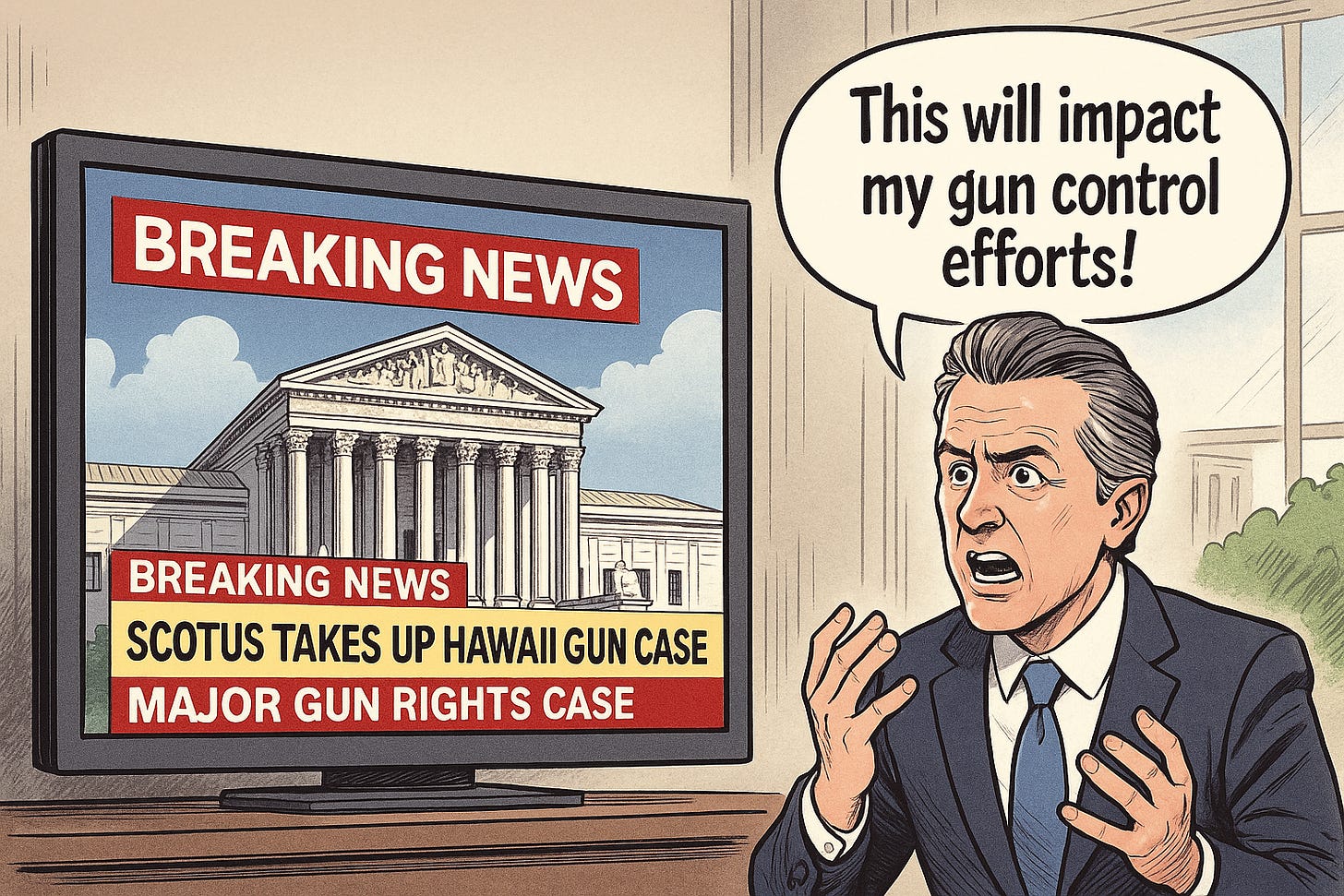*Breaking News* Supreme Court Agrees to Hear a Case Out of Hawaii That Could Blow a Hole in California’s New Restrictive Gun Law
A challenge from Hawaii may decide whether California can continue to treat nearly all private property as off-limits to lawful concealed carry.
🕒 5-minute read
A Challenge From the Islands
On Friday, the U.S. Supreme Court announced it would hear a challenge to a Hawaii law that would make exercising the right to carry a firearm nearly impossible. Under that statute, even citizens with a concealed-carry permit are barred from carrying on private property unless the owner gives express permission. It flips the usual rule: instead of property owners opting out of gun carry, they must now opt in through posted signs.
As the Hawaii Firearms Coalition, one of the plaintiffs in the case, explained:
“At the heart of this case, the Court will consider the following question: That Hawaii may presumptively prohibit the carry of handguns by licensed concealed carry permit holders on private property open to the public unless the property owner affirmatively gives express permission to the handgun carrier…
The Court will likely hear the case early next year, and its outcome could shape the future of carry rights not just in Hawaii, but across the entire nation.”
Plaintiffs argue this “default ban” makes lawful carry nearly impossible. They say it’s a shell game that nullifies the Second Amendment in daily life without banning it outright. The Court’s decision could change how states draw the line between property rights and personal freedom.
California should be watching closely. After the Supreme Court’s New York State Rifle & Pistol Association, Inc. v. Bruen ruling in 2022 affirmed a personal right to carry outside the home, the California Legislature rushed to narrow it again through Senate Bill 2. That law, signed by Governor Gavin Newsom, mirrored Hawaii’s approach: carrying a firearm on private property is banned unless the owner posts a sign granting permission.
California’s “Sensitive Places” Law on Thin Ice
Federal judges have already suspended SB 2’s private-property rule. The Ninth Circuit Court of Appeals left an injunction in place, concluding the state likely went too far with this provision. California can’t enforce that new regulation today—the old rule still applies.
That means a lawful CCW holder can carry on most private property open to the public, unless the owner forbids it. But Sacramento’s intent was clear: make gun carry so complicated and restricted that few citizens bother to exercise the right.
State leaders packaged SB 2 as a “public safety” reform, yet the timing told the story. It arrived within months of Bruen, as though lawmakers were pretending to follow the Court while quietly undermining it. They didn’t rewrite the Constitution, declare scores of new “no-carry” zones, or change the rule for private businesses.
SB 2 is broad and has a lot of egregious provisions. There is active litigation on SB 2, May vs. Bonta, where the case is going to trial. The plaintiffs include the California Rifle & Pistol Association, Gun Owners of America, Gun Owners of California, Liberal Gun Owners Association, the Second Amendment Foundation, and a number of individual California CCW permit holders.
If Hawaii’s rule is invalidated, California’s mirror-image default almost certainly will be, too, striking a key provision in SB 2.
Rights Versus Permissions
At the center of both the Hawaii case and California’s dispute is one question: what does a right really mean? A constitutional right does not depend on someone else’s permission to exist. When the government flips the default so that carry is illegal unless a property owner posts a specific sign, the right is meaningless.
The state could have stopped at reasonable “sensitive place” limits—schools, courthouses, and secure facilities. Instead, it created a vast map of forbidden zones. Even many public sidewalks abutting “sensitive” sites were included.
California politicians claim these restrictions “balance safety and rights.” But that’s not the legal test. The Supreme Court in Bruen rejected interest-balancing in favor of history and text: unless there’s a clear historical analogue for a restriction, it can’t stand. That’s the test Hawaii will face—and California by extension.
What’s Really at Stake
At first glance, this might seem like a technical legal debate about property boundaries and signage. It isn’t. It’s about whether states can use clever regulations to do what lawmakers couldn’t openly—gradually hollow out constitutional protections.
The Second Amendment doesn’t promise that responsible citizens will be comfortable exercising their rights. It promises that the government will not make those rights meaningless.
California has already seen federal judges push back on its overreach. The coming Supreme Court term could finally set a bright-line rule: that the state cannot presume every private space is a “gun-free zone” unless the owner says otherwise. If that’s how the Court rules, Sacramento’s death-by-a-thousand-rule strategy will hit a big road block.
So, Does It Matter?
This decision by SCOTUS to hear this case matters because it will decide whether constitutional rights stand independently—or depend on a bureaucrat’s permission slip. If the Court sides with the Hawaii plaintiffs, it will reaffirm that rights come from the people, not bureaucrats or permission slips.
And for Californians, it would send a message beyond firearms: that a right recognized by the Supreme Court is not an invitation for the Legislature to undermine it the next day. Either the Constitution still means what it says—or it doesn’t anymore.
For paid subscribers, there is something “extra” below the firewall. I will tease it by saying “Heston” and “Reagan”….
Keep reading with a 7-day free trial
Subscribe to So, Does It Matter? California Politics! to keep reading this post and get 7 days of free access to the full post archives.



